Report on Building Sustainable Organizations for SMEs
VerifiedAdded on 2022/12/29
|6
|1332
|84
Report
AI Summary
This report examines the challenges and solutions for Small and Medium Enterprises (SMEs) in building sustainable organizations. It identifies key issues such as lack of financial resources, time constraints, limited CSR activities, and outdated technology. The report proposes solutions including raising funds through government schemes and private lenders, adopting new technologies, and implementing effective marketing strategies. Real-world examples of sustainable SMEs are provided, such as Ozone Coffee and Williams Sonoma. The report concludes that by addressing these challenges and embracing innovation, CSR, and employee engagement, SMEs can achieve competitive advantages and long-term profitability. The government's role in providing financial aid and incentives is also highlighted as crucial for SME development.
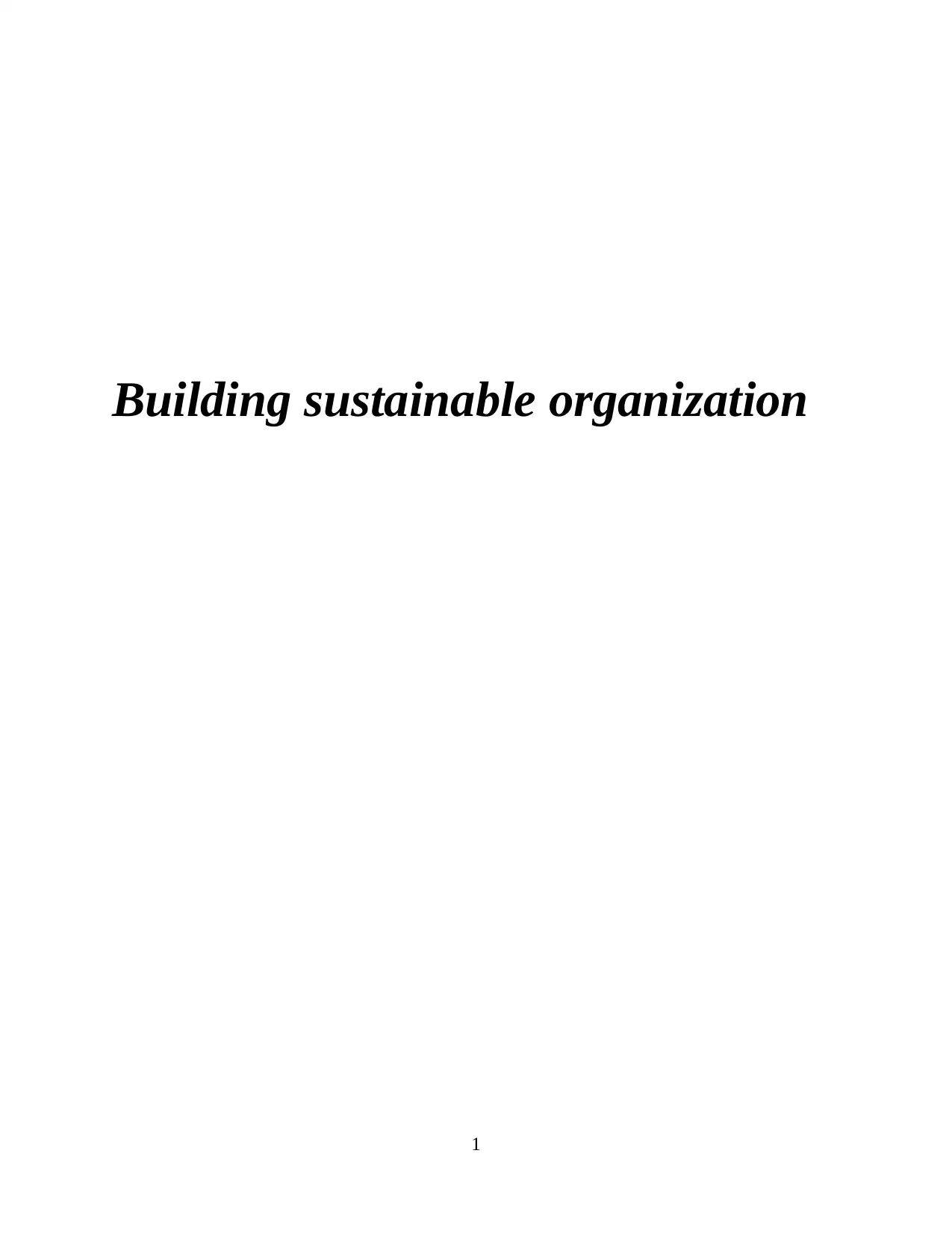
Building sustainable organization
1
1
Paraphrase This Document
Need a fresh take? Get an instant paraphrase of this document with our AI Paraphraser
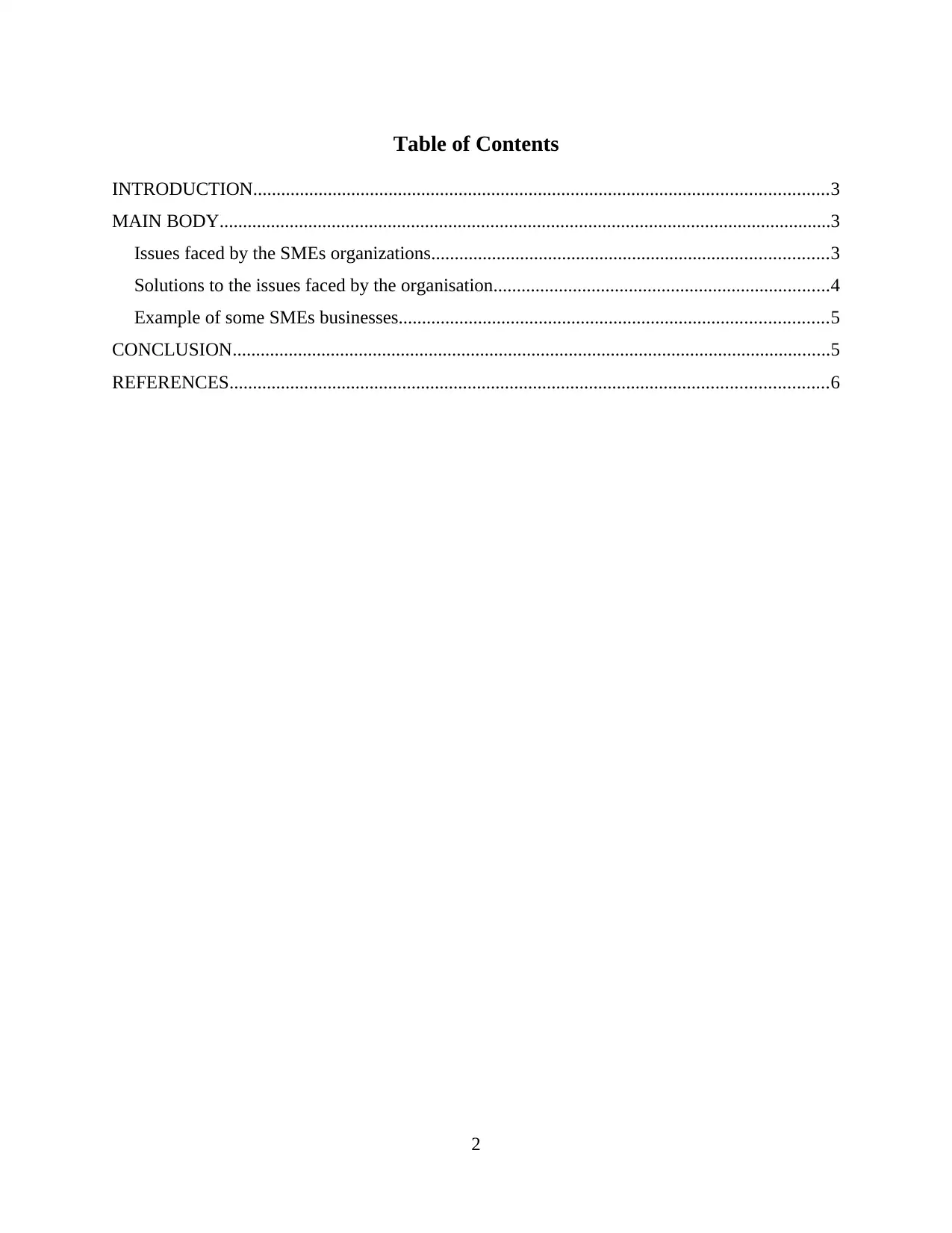
Table of Contents
INTRODUCTION...........................................................................................................................3
MAIN BODY...................................................................................................................................3
Issues faced by the SMEs organizations.....................................................................................3
Solutions to the issues faced by the organisation........................................................................4
Example of some SMEs businesses............................................................................................5
CONCLUSION................................................................................................................................5
REFERENCES................................................................................................................................6
2
INTRODUCTION...........................................................................................................................3
MAIN BODY...................................................................................................................................3
Issues faced by the SMEs organizations.....................................................................................3
Solutions to the issues faced by the organisation........................................................................4
Example of some SMEs businesses............................................................................................5
CONCLUSION................................................................................................................................5
REFERENCES................................................................................................................................6
2
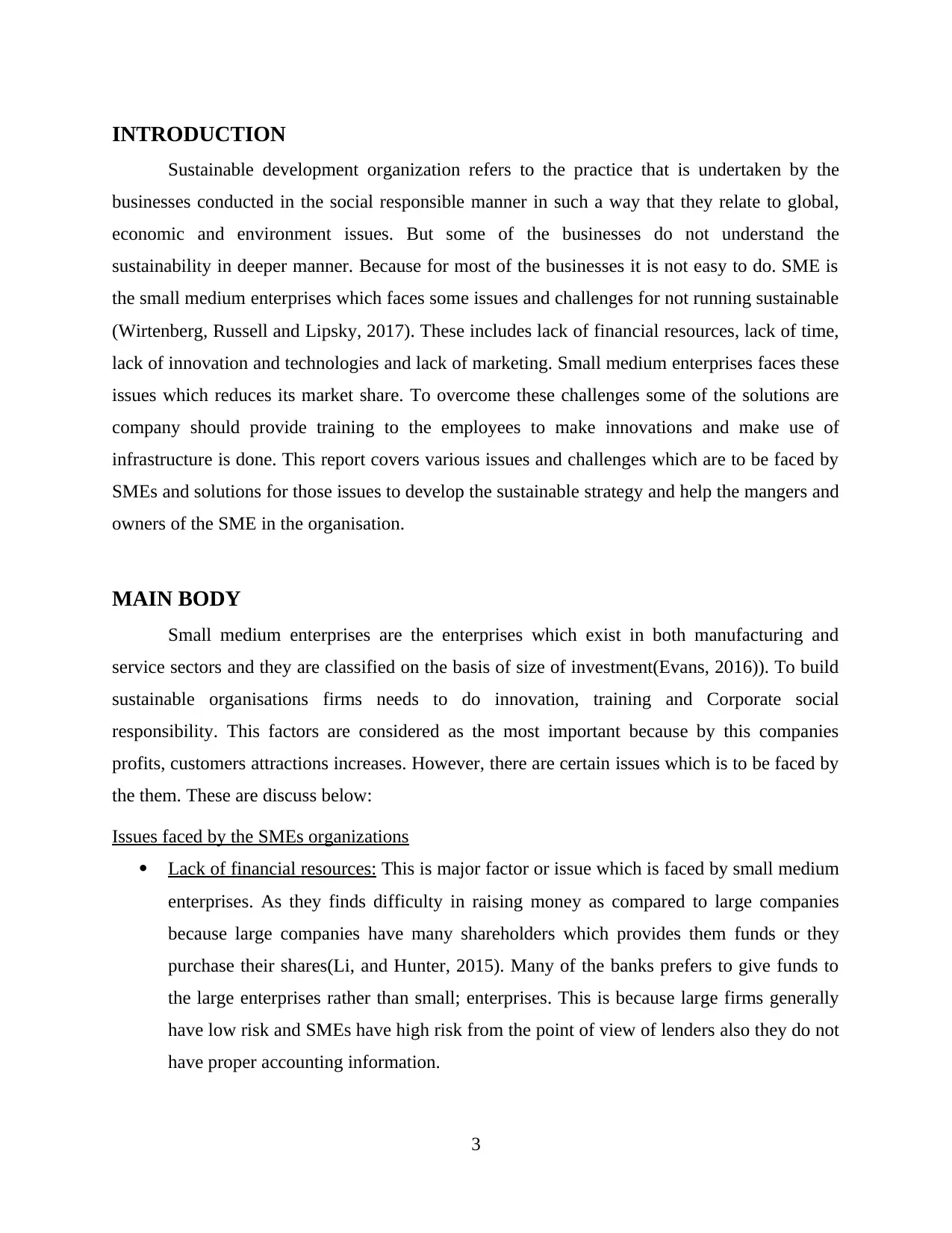
INTRODUCTION
Sustainable development organization refers to the practice that is undertaken by the
businesses conducted in the social responsible manner in such a way that they relate to global,
economic and environment issues. But some of the businesses do not understand the
sustainability in deeper manner. Because for most of the businesses it is not easy to do. SME is
the small medium enterprises which faces some issues and challenges for not running sustainable
(Wirtenberg, Russell and Lipsky, 2017). These includes lack of financial resources, lack of time,
lack of innovation and technologies and lack of marketing. Small medium enterprises faces these
issues which reduces its market share. To overcome these challenges some of the solutions are
company should provide training to the employees to make innovations and make use of
infrastructure is done. This report covers various issues and challenges which are to be faced by
SMEs and solutions for those issues to develop the sustainable strategy and help the mangers and
owners of the SME in the organisation.
MAIN BODY
Small medium enterprises are the enterprises which exist in both manufacturing and
service sectors and they are classified on the basis of size of investment(Evans, 2016)). To build
sustainable organisations firms needs to do innovation, training and Corporate social
responsibility. This factors are considered as the most important because by this companies
profits, customers attractions increases. However, there are certain issues which is to be faced by
the them. These are discuss below:
Issues faced by the SMEs organizations
Lack of financial resources: This is major factor or issue which is faced by small medium
enterprises. As they finds difficulty in raising money as compared to large companies
because large companies have many shareholders which provides them funds or they
purchase their shares(Li, and Hunter, 2015). Many of the banks prefers to give funds to
the large enterprises rather than small; enterprises. This is because large firms generally
have low risk and SMEs have high risk from the point of view of lenders also they do not
have proper accounting information.
3
Sustainable development organization refers to the practice that is undertaken by the
businesses conducted in the social responsible manner in such a way that they relate to global,
economic and environment issues. But some of the businesses do not understand the
sustainability in deeper manner. Because for most of the businesses it is not easy to do. SME is
the small medium enterprises which faces some issues and challenges for not running sustainable
(Wirtenberg, Russell and Lipsky, 2017). These includes lack of financial resources, lack of time,
lack of innovation and technologies and lack of marketing. Small medium enterprises faces these
issues which reduces its market share. To overcome these challenges some of the solutions are
company should provide training to the employees to make innovations and make use of
infrastructure is done. This report covers various issues and challenges which are to be faced by
SMEs and solutions for those issues to develop the sustainable strategy and help the mangers and
owners of the SME in the organisation.
MAIN BODY
Small medium enterprises are the enterprises which exist in both manufacturing and
service sectors and they are classified on the basis of size of investment(Evans, 2016)). To build
sustainable organisations firms needs to do innovation, training and Corporate social
responsibility. This factors are considered as the most important because by this companies
profits, customers attractions increases. However, there are certain issues which is to be faced by
the them. These are discuss below:
Issues faced by the SMEs organizations
Lack of financial resources: This is major factor or issue which is faced by small medium
enterprises. As they finds difficulty in raising money as compared to large companies
because large companies have many shareholders which provides them funds or they
purchase their shares(Li, and Hunter, 2015). Many of the banks prefers to give funds to
the large enterprises rather than small; enterprises. This is because large firms generally
have low risk and SMEs have high risk from the point of view of lenders also they do not
have proper accounting information.
3
⊘ This is a preview!⊘
Do you want full access?
Subscribe today to unlock all pages.

Trusted by 1+ million students worldwide
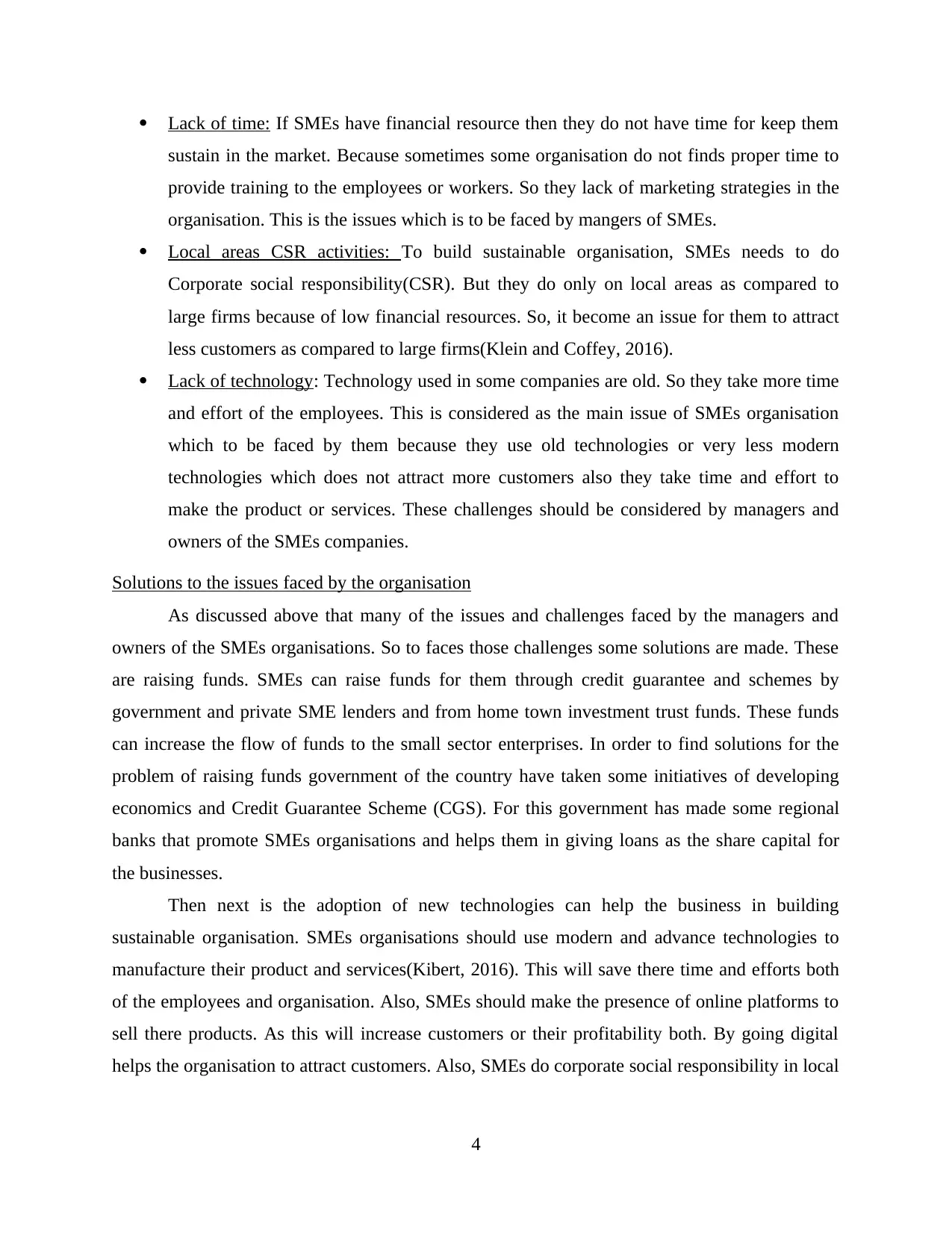
Lack of time: If SMEs have financial resource then they do not have time for keep them
sustain in the market. Because sometimes some organisation do not finds proper time to
provide training to the employees or workers. So they lack of marketing strategies in the
organisation. This is the issues which is to be faced by mangers of SMEs.
Local areas CSR activities: To build sustainable organisation, SMEs needs to do
Corporate social responsibility(CSR). But they do only on local areas as compared to
large firms because of low financial resources. So, it become an issue for them to attract
less customers as compared to large firms(Klein and Coffey, 2016).
Lack of technology: Technology used in some companies are old. So they take more time
and effort of the employees. This is considered as the main issue of SMEs organisation
which to be faced by them because they use old technologies or very less modern
technologies which does not attract more customers also they take time and effort to
make the product or services. These challenges should be considered by managers and
owners of the SMEs companies.
Solutions to the issues faced by the organisation
As discussed above that many of the issues and challenges faced by the managers and
owners of the SMEs organisations. So to faces those challenges some solutions are made. These
are raising funds. SMEs can raise funds for them through credit guarantee and schemes by
government and private SME lenders and from home town investment trust funds. These funds
can increase the flow of funds to the small sector enterprises. In order to find solutions for the
problem of raising funds government of the country have taken some initiatives of developing
economics and Credit Guarantee Scheme (CGS). For this government has made some regional
banks that promote SMEs organisations and helps them in giving loans as the share capital for
the businesses.
Then next is the adoption of new technologies can help the business in building
sustainable organisation. SMEs organisations should use modern and advance technologies to
manufacture their product and services(Kibert, 2016). This will save there time and efforts both
of the employees and organisation. Also, SMEs should make the presence of online platforms to
sell there products. As this will increase customers or their profitability both. By going digital
helps the organisation to attract customers. Also, SMEs do corporate social responsibility in local
4
sustain in the market. Because sometimes some organisation do not finds proper time to
provide training to the employees or workers. So they lack of marketing strategies in the
organisation. This is the issues which is to be faced by mangers of SMEs.
Local areas CSR activities: To build sustainable organisation, SMEs needs to do
Corporate social responsibility(CSR). But they do only on local areas as compared to
large firms because of low financial resources. So, it become an issue for them to attract
less customers as compared to large firms(Klein and Coffey, 2016).
Lack of technology: Technology used in some companies are old. So they take more time
and effort of the employees. This is considered as the main issue of SMEs organisation
which to be faced by them because they use old technologies or very less modern
technologies which does not attract more customers also they take time and effort to
make the product or services. These challenges should be considered by managers and
owners of the SMEs companies.
Solutions to the issues faced by the organisation
As discussed above that many of the issues and challenges faced by the managers and
owners of the SMEs organisations. So to faces those challenges some solutions are made. These
are raising funds. SMEs can raise funds for them through credit guarantee and schemes by
government and private SME lenders and from home town investment trust funds. These funds
can increase the flow of funds to the small sector enterprises. In order to find solutions for the
problem of raising funds government of the country have taken some initiatives of developing
economics and Credit Guarantee Scheme (CGS). For this government has made some regional
banks that promote SMEs organisations and helps them in giving loans as the share capital for
the businesses.
Then next is the adoption of new technologies can help the business in building
sustainable organisation. SMEs organisations should use modern and advance technologies to
manufacture their product and services(Kibert, 2016). This will save there time and efforts both
of the employees and organisation. Also, SMEs should make the presence of online platforms to
sell there products. As this will increase customers or their profitability both. By going digital
helps the organisation to attract customers. Also, SMEs do corporate social responsibility in local
4
Paraphrase This Document
Need a fresh take? Get an instant paraphrase of this document with our AI Paraphraser

areas which is necessary to sustain in the market. This will helps the organisation to compete
with other firms and gain competitive advantage and also attract more customers.
Example of some SMEs businesses
The example of SMEs is Ozone coffee which target high audience towards its brand with
a passion of social responsibility. As it educates on ethics which has created the brand that is
lovable by the customers. Another is Williams Sonoma which is SME organisation and it sells
high quality of cookware(Keeler and Vaidya, 2016). These companies also faces many issues
and challenges. But they select that content which can engage more customers.
CONCLUSION
From the above report it has been concluded that SMEs are the manufacturing and
service companies. They faces many challenges and issues within increasing competition in the
market. The adoption of new technologies, government schemes and professional trainers, it can
increase its innovation, creativity and CSR. But for some of the SMEs factors like lack of
resources. Lack of time and innovation can be the biggest issues and this can led to lack of
information and market experience. Issues like lack of R&D expenditure can be solved by the
government of the country as government should provide loans, grants and tax incentives. This
can help the organisation in achieving its competitive advantages and profitably. Owners and
mangers should perform there functions very well in the organisation by providing training to the
employees or workers and make them involve in decision making process. This will increase the
employees engagement and builds sustainable organisation.
5
with other firms and gain competitive advantage and also attract more customers.
Example of some SMEs businesses
The example of SMEs is Ozone coffee which target high audience towards its brand with
a passion of social responsibility. As it educates on ethics which has created the brand that is
lovable by the customers. Another is Williams Sonoma which is SME organisation and it sells
high quality of cookware(Keeler and Vaidya, 2016). These companies also faces many issues
and challenges. But they select that content which can engage more customers.
CONCLUSION
From the above report it has been concluded that SMEs are the manufacturing and
service companies. They faces many challenges and issues within increasing competition in the
market. The adoption of new technologies, government schemes and professional trainers, it can
increase its innovation, creativity and CSR. But for some of the SMEs factors like lack of
resources. Lack of time and innovation can be the biggest issues and this can led to lack of
information and market experience. Issues like lack of R&D expenditure can be solved by the
government of the country as government should provide loans, grants and tax incentives. This
can help the organisation in achieving its competitive advantages and profitably. Owners and
mangers should perform there functions very well in the organisation by providing training to the
employees or workers and make them involve in decision making process. This will increase the
employees engagement and builds sustainable organisation.
5
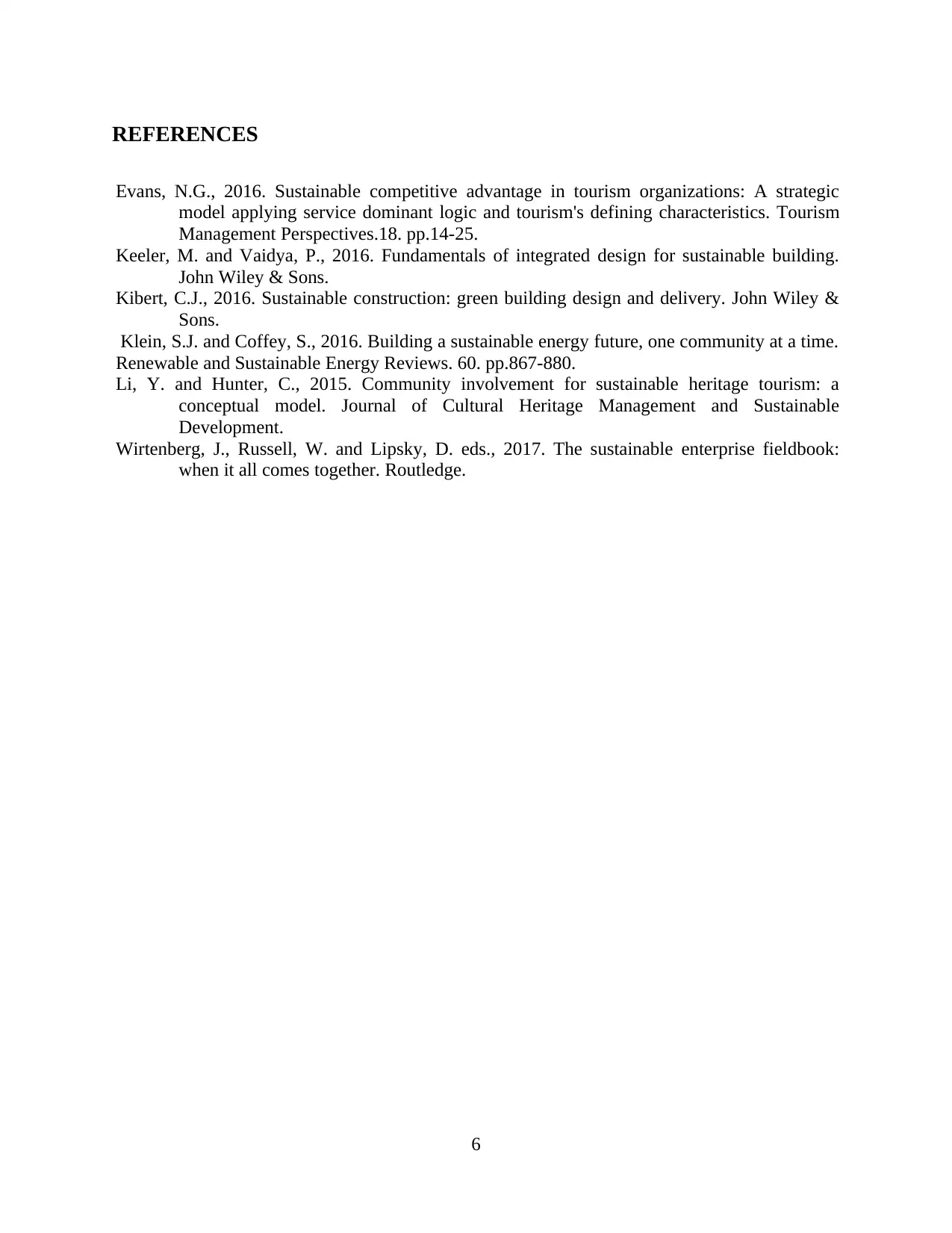
REFERENCES
Evans, N.G., 2016. Sustainable competitive advantage in tourism organizations: A strategic
model applying service dominant logic and tourism's defining characteristics. Tourism
Management Perspectives.18. pp.14-25.
Keeler, M. and Vaidya, P., 2016. Fundamentals of integrated design for sustainable building.
John Wiley & Sons.
Kibert, C.J., 2016. Sustainable construction: green building design and delivery. John Wiley &
Sons.
Klein, S.J. and Coffey, S., 2016. Building a sustainable energy future, one community at a time.
Renewable and Sustainable Energy Reviews. 60. pp.867-880.
Li, Y. and Hunter, C., 2015. Community involvement for sustainable heritage tourism: a
conceptual model. Journal of Cultural Heritage Management and Sustainable
Development.
Wirtenberg, J., Russell, W. and Lipsky, D. eds., 2017. The sustainable enterprise fieldbook:
when it all comes together. Routledge.
6
Evans, N.G., 2016. Sustainable competitive advantage in tourism organizations: A strategic
model applying service dominant logic and tourism's defining characteristics. Tourism
Management Perspectives.18. pp.14-25.
Keeler, M. and Vaidya, P., 2016. Fundamentals of integrated design for sustainable building.
John Wiley & Sons.
Kibert, C.J., 2016. Sustainable construction: green building design and delivery. John Wiley &
Sons.
Klein, S.J. and Coffey, S., 2016. Building a sustainable energy future, one community at a time.
Renewable and Sustainable Energy Reviews. 60. pp.867-880.
Li, Y. and Hunter, C., 2015. Community involvement for sustainable heritage tourism: a
conceptual model. Journal of Cultural Heritage Management and Sustainable
Development.
Wirtenberg, J., Russell, W. and Lipsky, D. eds., 2017. The sustainable enterprise fieldbook:
when it all comes together. Routledge.
6
⊘ This is a preview!⊘
Do you want full access?
Subscribe today to unlock all pages.

Trusted by 1+ million students worldwide
1 out of 6
Related Documents
Your All-in-One AI-Powered Toolkit for Academic Success.
+13062052269
info@desklib.com
Available 24*7 on WhatsApp / Email
![[object Object]](/_next/static/media/star-bottom.7253800d.svg)
Unlock your academic potential
Copyright © 2020–2025 A2Z Services. All Rights Reserved. Developed and managed by ZUCOL.





